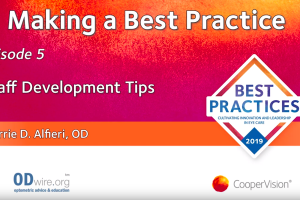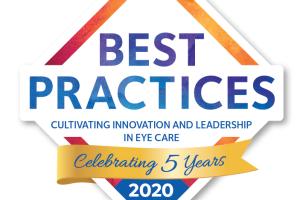2020 Best Practices honoree Dave Anderson of Miamisburg Vision Care in Miamisburg, Ohio discusses finding, training, and retaining a great staff.

Identifying, training, developing, and retaining quality eye care staff is an ongoing challenge for most optometry practices. It has been reported that the average retention rate for employees in the healthcare industry is 2.9 years1, making the finding and training of new staff members a regular need for most eyecare practices. The uncertainty and changes brought about by the COVID-19 pandemic heightened staff turnover for many businesses as well2. Identifying the right candidates for the right positions, recognizing their strengths, weaknesses and learning preferences, and leveraging the many available resources for training can help make the process less daunting.
Identifying and Hiring New Staff Members
Hiring staff requires a combination of looking for the right fit within current staff mix along with the personality and skill set required for a specific position. Long ago, I used to hire based upon experience, especially experience in the specific area that I need to fill. The criteria was more about years in optical versus the ability to relate to patients. Over the last 10 years, I look at the position and what are the main qualities the are important for that position, and I then find those in applicants. For example, if it is someone that is a front desk, first point of contact person, they need to be friendly, able to manage many things at one time, able to be flexible to help patients but also able to maintain organization amongst chaos. If it is someone that works with contact lenses, they require attention to detail due to the number of lenses that need re-ordered along with the patient orders, they need to have lots of patience especially for new fits and they need to be able to maintain a large volume of information that constantly changes (new rebates, new lenses, new parameters, new solutions) and be flexible and willing to adapt to the changes.
Training New Hires
Training new hires in my office begins with the basics, every new hire spends a day or two working as a pre-tester so they can fully understand the amount of patients, the variety of problems we help solve and the pace that our office works at. Once they have a good understanding of the first part, we then plug them into the area they were hired for and let them work side by side with someone in that same area. The main reason for this is to ensure they are learning from the subject matter expert but it is also to let our trainer get an understanding of the skill set that new hire has. While we claim to be good at personality evaluation, sometimes we miss the mark, but after on the job learning and training, often times we can find the right fit for the new hire. The bottom line, I am a firm believer in putting a person in a position for success. A type A by-the-book personality is not a good fit for the front desk greeter, but they are ideal in a position that requires precision all day long.
Providing Ongoing Development Opportunities
Every day, I choose an interesting or difficult situation or patient to use as a “case study” that we all learn from. I spend no more than 5 minutes, mostly with the newest staff, but often times even with the most experienced to help everyone understand what we are doing and help them better grasp of the concepts needed to be experts. We also have monthly meetings for each area, contact lens, optical, technician, reception/billing/check out and we make sure everyone is on the same page, and we introduce at those meetings areas that either need fine tuned or areas that are new. Just last month, we spent time working with our optical staff working on trouble shooting vision complaints with glasses. I picked 6 frames and lenses that had current issues that our lead optician already found that needed sent back for various issues and challenged our other optical staff to find the problem. I provided the patient complaint and let them try come up with the solution. The person with the most correct solutions was given a gift card and celebrated in the office wide meeting. I have also felt the best way to truly learn is hands on, so any time I come across an issue, a learning opportunity or a mistake, I draw attention to it and help them understand the value of accuracy along with ways to help combat this issue in the future. Finally, a big thing that has been a hit with all staff is a semi-annual “what we do in our office” jeopardy contest of some cases that were tough, situations that are challenging or things that just come up. One of the topics early in 2020 was “Silly questions and how to answer them” and they included “why is a contact lens exam more” and “why do your glasses cost more than XYZ.” It is always a great way to get all staff involved, but also help provide information in a fun and simple way to empower them to better help patients.
Leveraging Available Resources
For years, I have looked for great resources to help train staff, and nearly every vendor, every association and every doctor alliance has so many great resources available. I have always relied on my doctor alliances as a starting point, along with our subject expert to help begin the training. Once this begins, we find out the type of learner the new staff member is, and point them in the direction that is best suited to them. Some are more hands on, some appreciate live webinars, some enjoy book learning and some prefer a wide mix. Regardless, I never feel any one resource is enough, and I always make sure the training is further enhanced by sending the new staff within the first 1-2 years to a live conference. The learning experience at a conference, even just a walk through the exhibit hall, really starts to tie everything together to truly help the staff member apply these learnings to real patient care.
One of the biggest lessons I have learned over time is that no one staff member will respond the same way to various things we do, be it in the form of reward systems or training. I think being flexible and adaptable to new training models, relying on experienced staff and understanding that both persistence and consistency is key to success. Just like training your teenager to drive, a few minutes here and there is never enough.
- Bureau of Labor Statistics 2016.
- Maurer R. Turnover Tsumani expected once pandemic ends. March 2021.

Dr. Dave Anderson is a 2004 graduate of The Ohio State University College of Optometry. He is a past president of the Ohio Optometric Association (OOA) and continues to serve on many committees at the state and national level. Dr. Anderson enjoys advocating for his patients and has been involved in the passage of many bills, including the elimination of sales tax on optical items. He lectures and authors articles on eyecare and practice management topics. Dr. Anderson enjoys the challenge of treating glaucoma and other eye diseases, with a special focus on Dry Eye Disease and Myopia Management. He is a former instructor at The Ohio State University College of Optometry in Ocular Disease Clinic, and has been an investigator in clinical trials for contact lenses and ocular pharmaceuticals.








